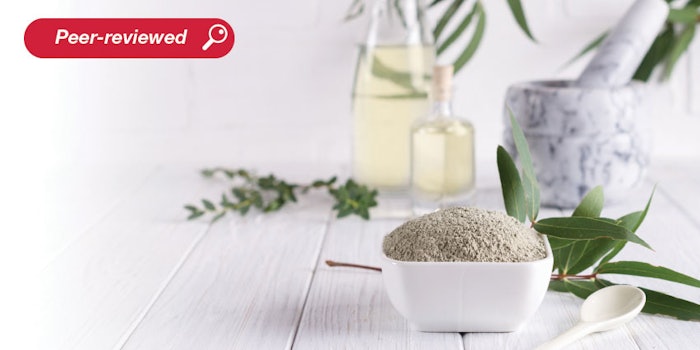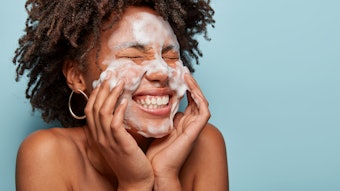
Read the full article in the March 2022 digital edition. . .
*Editor’s note: This research was initially presented at the 31st IFSCC Congress, in Yokohama, Japan (Nov 2020).
A quality compact powder product should have a uniform color and be strong enough to resist breakage through everyday use, yet be soft enough to provide sufficient payoff. Binders are liquid or solid substances that hold other materials together, which is crucial in pressed powder cosmetics. Binders work by replacing the interstitial air and reducing the surface tension, which increases intermolecular forces between particles and therefore leads to higher density and adhesion/cohesion forces.1
Binder concentration has a direct impact on the quality of any compact, including consumer acceptability and manufacturing processability. The concentration also dictates whether a powder is cohesive enough to form a stable, uniform compact upon compression while remaining sufficiently free-flowing to be processed in subsequent manufacturing steps where it is blended; transported through hoppers and feeders; and filled into compacts and compressed. Powders that do not have adequate flowability can cause inconsistent batches, frequent stoppages or incomplete filling—requiring additional time and resources.2
The pressure at which a powder is pressed also influences the quality of the compact, with very high pressure resulting in a compact that is too hard with poor payoff and a tendency to glaze. Very low pressure produces a soft compact that is prone to breakage and rubs off easily. Pressure usually varies from 300 psi to 2,000 psi,3 depending on factors such as product composition, binder concentration, number of press steps or press duration.
Pigments can be prone to degradation by a variety of factors such as temperature, humidity, oxidation and light, both visible and ultraviolet (UV). Color stability is essential for consumer acceptability, therefore the addition of a binder mustn’t reduce a pigment’s chemical stability. It is speculated that some binders could even aid in protecting the pigment from degradation by mechanisms such as hydrophobic coating and UV protection. Liquid binders in powder cosmetics wet the pigments and improve their ease of dispersion by displacing the air from the particles’ surface and replacing it with a liquid, which is crucial to develop the full strength of the color.4 Consequently, the main roles of liquid binders in pressed powder cosmetics are to improve color intensity (by wetting the pigments), to maintain color stability and to increase the powder cohesiveness (and thus reducing powder flow) to the desired level.
In the past, the combinations of gums, sugars and soaps have been used as binders. Nowadays, the most common liquid binders are silicone-based or hydrocarbon-based from petrochemical sources.5 According to Mintel,6 more than 60% of color cosmetics contain silicones. Silicones are most widely used for their hydrophobicity, spreadability, water and oxygen impermeability, and the unique soft skin feel they confer. The most commonly used silicone binders in pressed powders are cyclopentasiloxane, dimethicone and dimethicone crosspolymers. Studies by Stevens7-9 into the biodegradability of silicones showed that while they are not biodegradable, non-volatile polydimethylsiloxanes are degradable in soil, and volatile silicones such as cyclopentasiloxane degrade in the air in the presence of sunlight—ultimately to silica, water and carbon dioxide.
Due to a discordant history of safety, environmental impact and their synthetic nature, consumers have a poor perception of silicones. Despite studies confirming the non-occlusive behavior of commonly used silicones,10, 11 consumers and mainstream media still perceive them as such.12-14 Paired with the current market trends toward natural products, environmental concerns and sustainability,15, 16 there has been an increase in consumer demand for silicone-free, palm oil-free and natural products from sustainable sources.17 The cosmetic industry has responded by including natural emollients from sustainable sources to its portfolios, including their refined versions in the form of esters, triglycerides or alcohols.
The present study aimed to evaluate a range of natural binder alternatives and compare them with a silicone standard. Given the fact that most information on binders and their properties is provided by raw material suppliers with no comparative data, carrying out an inter- and intra-formulary comparison of different binders could be beneficial for future formulating strategies.
Materials and Methods
Ingredients: Talc was used as a bulking agent, with a mixture of methylparaben and propylparaben as the preservative. CI 77510, also known as ferric ferrocyanide, Prussian blue or iron blue, was used as a pigment. It is graded color-stable and enabled testing of the influence of variable binders on the pigment, independent of the light conditions.
The three selected binders were liquid emollients from sustainable, plant-based sources. These were compared with medium-weight dimethicone (DM). All were used at three concentration levels and two different press forces. DM was chosen due to its status as the most widely used silicone in powder cosmetics.
. . .Read more in the March 2022 digital edition. . .
Acknowledgments: The authors wish to thank Azelis (UK) for generously supplying the ingredients used in this study.
References
- Prescott, J. K. and Barnum, R. A. (2000) On powder flowability. Pharm Technol 24(10) 60-85.
- Freeman, T. (2021, July 22) Analytical techniques for successful cosmetic compact manufacture. Available at https://www.pharmaceuticalonline.com/doc/analytical-techniques-for-successful-cosmetic-0002
- Schlossman, M.L. and Feldman, A.J. (1971). Trends in pressed powder technology. J Soc Cosmet Chem 22(10) 599-614.
- Kutz, M. (2011, Jul ). Applied Plastics Engineering Handbook Processing and Materials. Waltham: William Andrew.
- Baki, G. and Alexander, K.S. (2015). Introduction to Cosmetic Formulation and Technology. Hoboken: John Wiley & Sons.
- Mintel. (2016). Global new product database. Available at: https://www.mintel.com/global-new-products-database
- Stevens, C. (1998). Environmental degradation pathways for the breakdown of polydimethylsiloxanes. J Inorg Biochem 69(3) 203-207.
- Stevens, C. (1998). Environmental fate and effects of dimethicone and cyclotetrasiloxane from personal care applications. Int J Cosmet Sci 20(5) 296-304.
- Stevens, C., Powell, D. E., Mäkelä, P. and Karman, C. (2001). Fate and effects of polydimethylsiloxane (PDMS) in marine environments. Mar Pollut Bull 42(7) 536-543.
- de Paepe, K., Sieg, A., le Meur, M. and Rogiers, V. (2014). Silicones as nonocclusive topical agents. Skin Pharmacol Physiol 27(3) 164-171.
- Garaud, J. (2014) Silicones as innocuous materials to keep natural moisture balance and protect skin against particle pollution. SOFW Journal (140) 26-34.
- Young Chester, K. (2018, Apr 5). How silicone based primers are ruining your pores. Eminence Organic Skin Care. Available at: https://eminenceorganics.com/ca/blog/2018/04/05/how-silicone-based-primers-are-ruining-your-pores
- Germain, P. (2021, Jul 5). Are silicones good or bad? COSSMA. Available at: https://www.cossma.com/ingredients/article/are-silicones-good-or-bad-34098.html
- Villet, M. (2021, Mar 27). 7 reasons to avoid silicones on your skin. The Skincare Edit. Available at: https://theskincareedit.com/2017/03/28/why-avoid-silicones-on-skin
- Mintel. (2018). The millennial BPC consumer. Available at: https://reports.mintel.com/
- Mintel. (2019, Jan). Beauty and personal care retailing. Available at: https://reports.mintel.com/
- Mintel. (2018). Human ethics can boost palm oil’s profile. Available at: https://reports.mintel.com/











